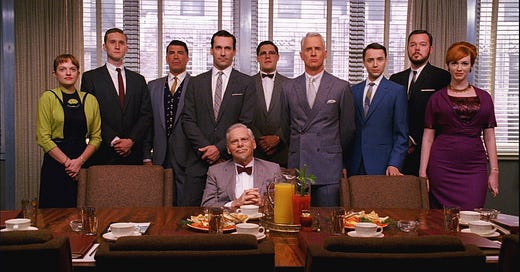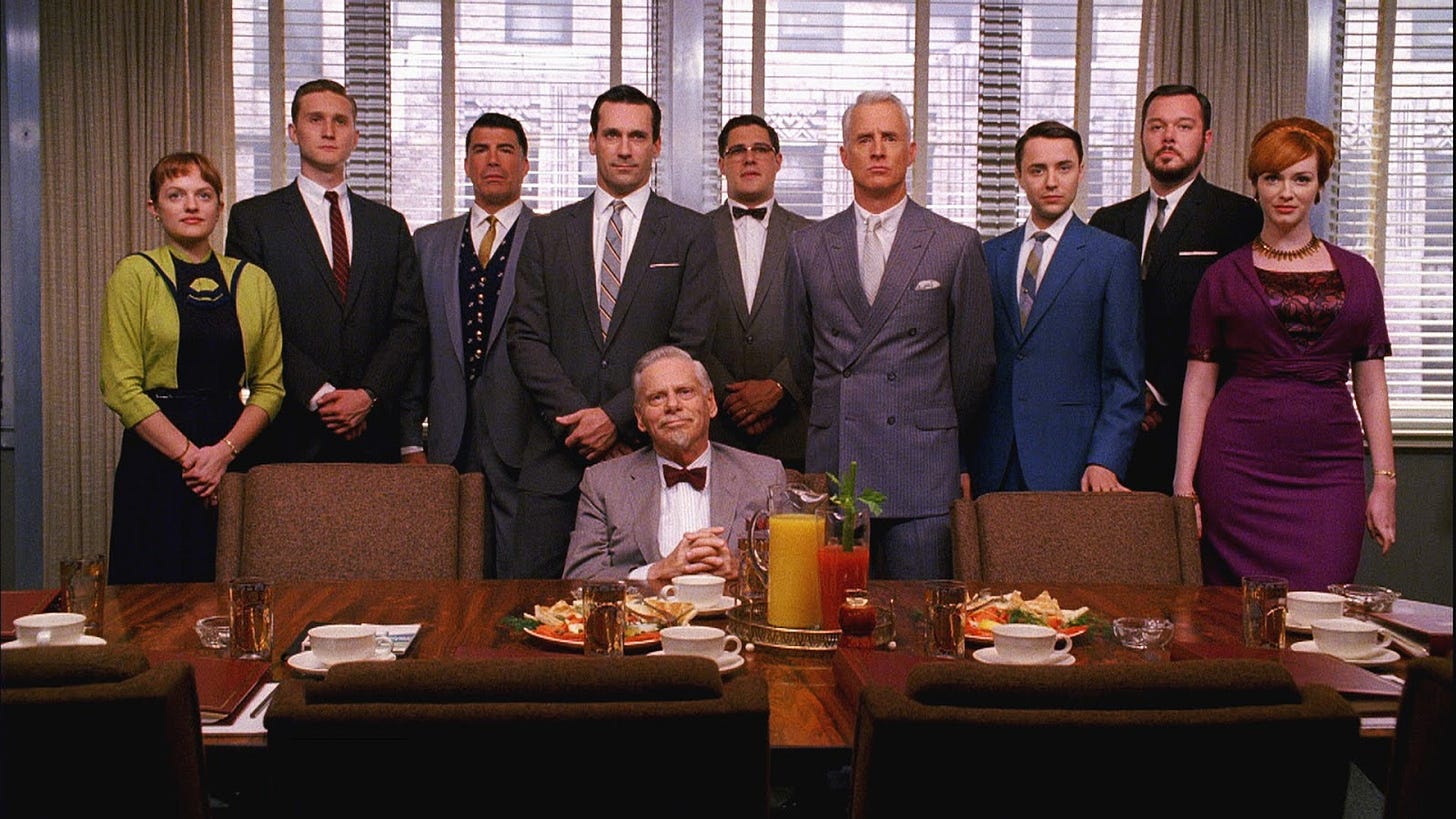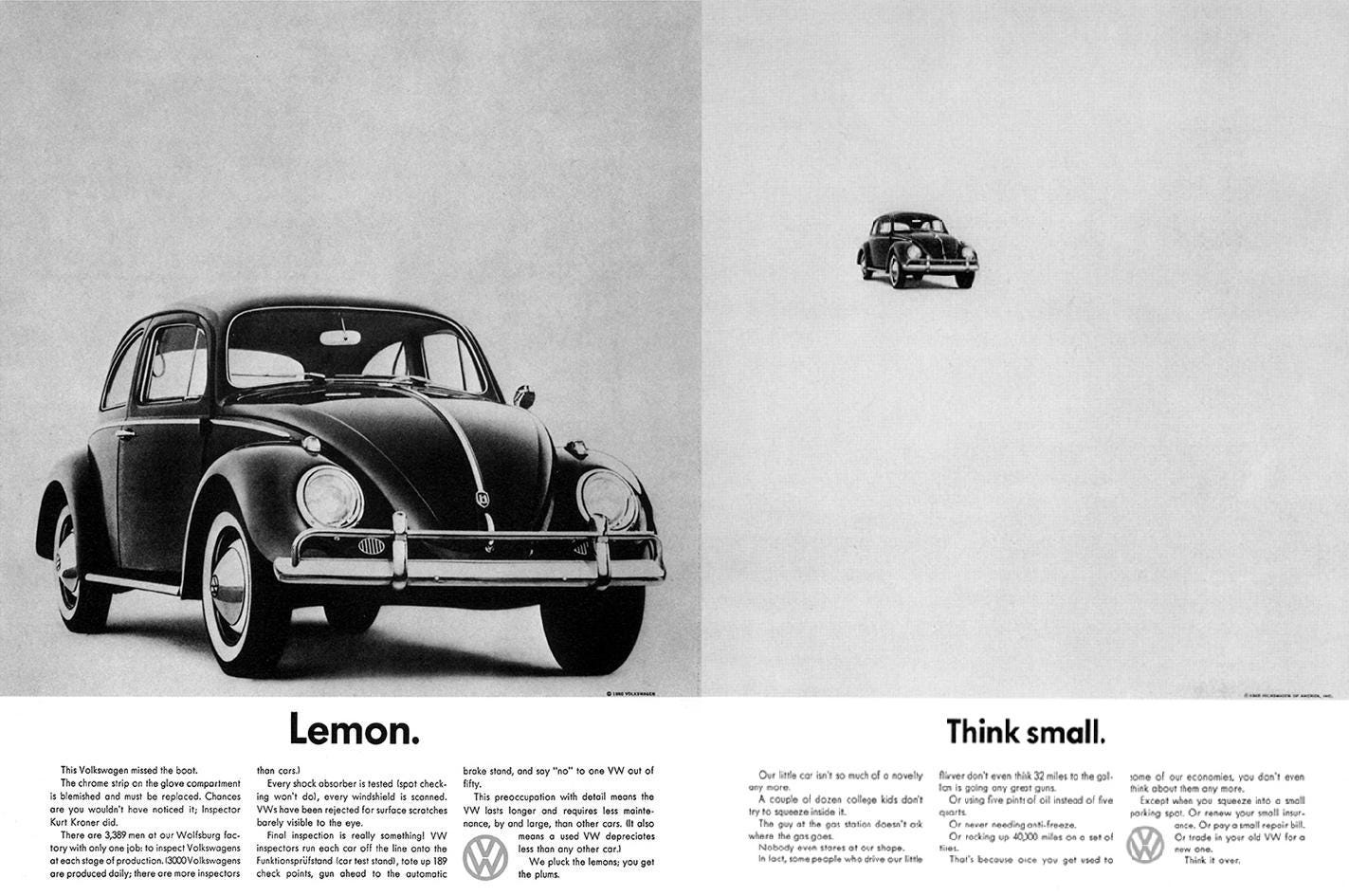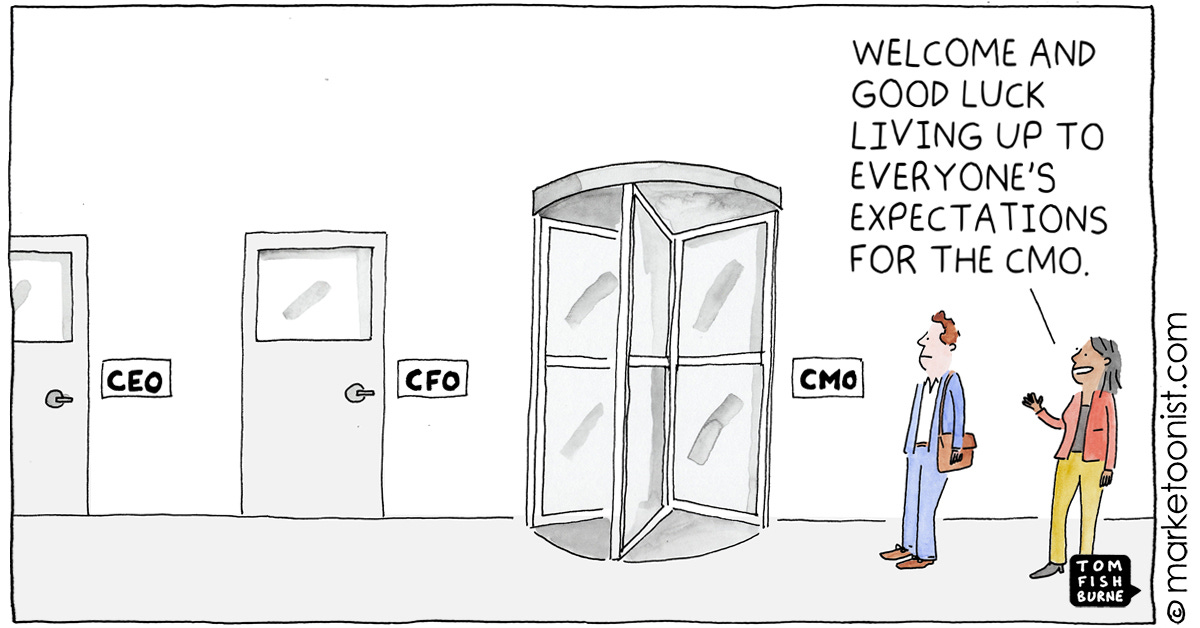Where is the next creative revolution?
Advertising invented the idea of "creative teams" in the 1950s. There's tension between design and marketing. Most startups don't know what to do in the post-ZIRP era. What does the future look like?
An unemployed copywriter searching for a job walked into his interview at the William Weintraub agency in Manhattan in 1941. His method for creating advertising was the same as all writers before him: he came up with some copy and then passed it down to the layout department, where a bullpen of artists would whip up some “roughs” or “pastels.” The writer? Bill Bernbach.
Keywords: passed down. Writers and designers worked in separate rooms, on separate floors. This was the model of the advertising world before television when posters represented much of our visual communications.
But not at Weintraub.
Weintraub appointed a young, promising designer as Head of Art: Paul Rand. Rand, who had already received international recognition for his designs with Esquire and Direction, worked with Bernbach for a few years. Rand was expanding the edges of traditional American advertising by making quirky, witty, and visually memorable ads. Rand didn’t treat ads as a thing to be designed. He saw them as whole ideas themselves.
Through Rand's tutelage and friendship, Bernbach’s love for language became fused with a deeper appreciation for design and the overall creative process. They visited museums and art galleries together, and Rand would point out how images paired with words would work.
“This was my first encounter with a copywriter who understood visual ideas,” Rand recalled, “and who didn't come in with a yellow copy pad and a preconceived notion of what the layout should look like.”
The famous art director George Lois, who knew Rand and Bernbach very well, recalls:
“The seed for advertising’s Creative Revolution was planted when Bernbach met Rand at the Weintraub agency. Here was an art director who not only wrote and designed his own ads—he also didn’t take any shit from anybody. Meeting Rand, Bernbach had an epiphany about the whole creative process. He realized that advertising could be ten times better if a talented writer works with a talented art director.”
From this seed sprouted a new model for advertising agencies. Rand and Bernbach’s collaborative spirit inspired the “creative team” concept, changing the industry forever.
How ideas were generated in earlier days would be perplexing today.
The creative department had little control. It was the accounts people who told copywriters what to do. Suits … telling artists … what to do? Can you imagine? Then, copywriters “passed down” their work to the art department. It was rare for designers and writers to know each other.
Before the creative team approach, many ad agencies’ mastheads showcased the copywriters’ names only: David Ogilvy, Leo Burnett, Raymond Rubicam. And then in the 1950s and ‘60s, it became about the art director and copywriter combo, like Ammirati & Puris, McCann Erickson, and the agency that Bill Bernach would start in 1949 with Ned Doyle and Maxwell Dane, DDB.
Under Bernbach’s high standards and creative leadership that united design and language to tell stories, DDB became a giant in the industry, producing ads that are still discussed today, from Polaroid to Alka-Seltzer to Volkswagen.
He proved that commercial creativity didn’t need to sacrifice beauty, wit, and grace to be effective. Advertising and design worked much better when they embraced these qualities—when they strived to be relentlessly unboring. Quirky. Imaginative. Powerful.
And of Rand? He broke the isolation between art and copy. “His sense of responsibility to the reader and his emphasis on quality and good taste” changed advertising—and the attitude of growing a business and building a brand—forever.
Has anything changed?
In 1981, design critic Ralph Caplan penned an essay calling designers "the exotic menials.”
I fear that many companies still have this attitude toward designers.
"I want finally to address in some detail, a role that I call 'the designer as exotic menial.' He is exotic because of the presumed mystery inherent in what he does, and menial because whatever he does is required only for relatively low-level objectives, to be considered only after the real business decisions are made. And although this is a horrendous misuse of the designer and of the design process, it is in my experience always done with the designer's collusion."
Sound familiar at all?
Is this how design is treated at your organization? An afterthought? A “go make me some stickers by EOD” department?
Michael Bierut wrote in 2006 about the persistence of the exotic menial, challenging whether a designer's role is any different 25 years later.
Bierut nailed it when he said…
“Yearning for the spotlight — respect from the business community and attention from the general public — has been a ceaseless, all-consuming theme of ambitious designers for the last quarter-century, and maybe long before that.”
He said this just a few years before the rise of digital applications and the boom of venture-backed tech startups. Software expanded the design world with product and UX/UI design, pushing graphic design, illustration, motion, and branding.
The path to making six figures in design is now well-worn because of tech startups. A Principal Product Designer should make as much as the top engineers and probably more than a U.S. senator. I know illustrators—yes, people who draw for a living—who make a salary that would make anyone pursuing a doctor or lawyer's path question their choices.
Read a good take here on the vanishing “visionary” designer.
“Visionary designers have lost their conceptual integrity to an industrial complex optimized for consensus, predictability, and short-term business gain. The rise of data-driven culture cultivated a generation of designers who only take risk-free and success-guaranteed steps towards the inevitable local maxima of design monotony.
[…]
Companies say they are “design-driven,” but designers are driven by dashboards filled with metrics like CSAT, NPS, CES, DAU, MAU.”)
I would argue that at most companies, yes, designers got a seat at the table… on someone else’s lap.
And the reason is because of marketing’s influence and power—its roots in advertising—and an economy that allowed for exponential business growth.
What happened to creative teams?
Bill Bernbach said, “An idea can turn to dust or magic depending on the talent that rubs against it.”
Looking at the history of creative teams that started with Bernbach and Rand makes me wonder: When is the next creative revolution coming? Where will it begin?
Here are a few dots to connect to understand why we lost creative teams and went into a world of marketing, spreadsheets, frameworks, and what feels like a total abandonment of good writing, tasteful ideas, creativity, and storytelling:
Tech startups and their margins are delicious. So, a lot of money flooded into these kinds of companies, creating new demands, roles, and systems.
For the past ten years, we lived in a “growth at all costs” mentality. This allowed insanely bloated teams inside startups and marketing to gain more power.
Growth Hacking was the first sign of rot in the industry, born from that short-term mentality. There was a widespread delusion that you could track specific metrics monthly, pour your free interest ZIRP money into the advertising machine, and poof, you have magical 10x growth for your company. It worked for a few companies for a short time. Good ideas don’t work that way, nor does building a long-standing company or brand.
This allowed mediocre marketers to get unmerited promotions because they could play the growth hacking game without producing anything good, useful, or interesting. This might explain why I meet many marketing executives without technical skill, taste, writing chops, design muscle, or vision. They’re good at spreadsheets, buying ads, and claiming success on their LinkedIn, saying things like “Helped grow the company 300% YOY.” I don’t hate the players, I’m just talking about the game.
I started my career in content marketing. It was a rare time for writers to get paid a tech salary while doing what we love: researching, writing, storytelling, and talking to customers. But that road hit a dead end when growth hacking and other tactics/levers became more seductive like influencers.
The post-ZIRP era that we’re entering will be very telling. Companies will need to think hard about how to do better org design to survive and hire people who can make things rather than having meetings about making things.
Now, companies treat ideas like putting widgets into a box. Rather than a designer and marketer working together to make something, one team often passes a Google or Notion doc to another team to execute.
So, what happened to creative teams? Something juicier: the internet, search engines, Google and Facebook ads, the ZIRP era and venture-backed startups, growth at all costs, IPO at all costs, get rich at all costs, exit quickly and move onto the next one.
This is how bad things are getting. Marketers are leading design teams. Big yikes. Probably because there’s a shortage of real design leadership. I believe most designers don’t want to work in-house at a B2B tech startup because of the persistence of the exotic menial. This is also why the top companies still hire brand agencies—some attempt to build an in-house agency.
The shift from creative to marketing teams happened because of tech and venture-backed startup culture. Yet, despite ample resources and far greater tools, the quality of marketing today is laughable compared to the Bernbach era. The severe lack of taste and imagination reveals this industry's breaking point, not because marketers are terrible people (I know I drill down on the industry hard), but because the game they have to play is just so fucked.
I also think this is such an interesting moment for change.
What happened to taste? Craft? Imagination? Being different?
On May 15, 1947, an ambitious and fully formed Bill Bernbach wrote a letter to the executives at the agency he worked, Grey. The executives responded too slowly, making Bill leave the agency and start his own.
His sentiment feels too relevant for today’s time—emphasis mine.
“Our agency is getting big. That’s something to be happy about. But it’s something to worry about, too, and I don’t mind telling you I’m damned worried. I’m worried that we’re going to fall into the trap of bigness, that we’re going to worship techniques instead of substance, that we’re going to follow history instead of making it, that we’re going to be drowned by superficialities instead of buoyed up by solid fundamentals. I’m worried lest hardening of the creative arteries begin to set in.
There are a lot of great technicians in advertising. And unfortunately they talk the best game. They know all the rules. They can tell you that people in an ad will get you greater readership. They can tell you that a sentence should be this sort [sic] or that long. They can tell you that body copy should be broken up for easier reading. They can give you fact after fact after fact. They are the scientists of advertising. But there’s one little rub. Advertising is fundamentally persuasion and persuasion happens to be not a science, but an art.”
[…]
It’s that creative spark that I’m so jealous of for our agency and that I am so desperately fearful of losing. I don’t want academicians. I don’t want scientists. I don’t want people who do the right things. I want people who do inspiring things.
He then ends with a sentiment I wrote on a Post-it that sits before me.
“If we are to advance we must emerge as a distinctive personality. We must develop our own philosophy and not have the advertising philosophy of others imposed on us.
Let us blaze new trails. Let us prove to the world that good taste, good art and good writing can be good selling.”
Looking at the industry I am currently in, I am astounded by what passes as writing or expressing an idea.
“We are fast!” “We are affordable!” “We are human!” “We’ll save you time!” Yeah, no fucking shit, thanks. Every company is doing all those things. Whether your product is data analytics, HR, crypto, food delivery, dog grooming, booking an appointment, or note-taking, all these apps seem to promise the same things.
Fear is also baked into everything because companies are on borrowed money and time. This is why most startups copy each other, look the same, and fear standing for something, not realizing this is why they fail.
This is an important pattern to watch out for, especially if you’re a creative person on the career treadmill, hoping to get a free house someday.
Now that we’re leaving the ZIRP era, how things were done in 2010 will not be useful in the next decade. So many tactics and levers that worked no longer do, like content marketing (it works, just not the way it did). There isn’t free money to overhire and throw at ads for growth. You can’t hire eight people for some company side project.
It sounds like companies will need to develop taste and ideas. Ut oh.
Maybe this is too cynical, but most startup founders and investors, I think, would rather have a team of engineers to build a product, a crew of product designers to boss around, and a sales function to sell the product. Fuck marketers and designers, the whiny creative brats.
Being a design-led organization is too perplexing to the creatively illiterate executives who work in tech. They don’t understand it. They think brand is bullshit. And their job is to increase shareholder value and ensure the investors are happy. Marketing and buying ads are the easiest levers. This is not about building a long-term company. It’s about building something that gets acquired and makes the early people rich.
Expand the Creative Team
My theory?
Teams will get smaller, and the media will love writing about them. I think the next hot startups will be teams of under ten to twenty people, seemingly doing the work of 100 to 200 people. They’ll get product-market fit faster, iterate their product quicker, and go to market with fresh and original ideas that overshadow their competitors. They’ll skip the bullshit bureaucracy that so many companies are drowning in. They’ll prioritize faster, and in turn, build insanely great products.
Bring back the designer + writer combo. God knows my brain needs it because reading incoherent copywriting is painful.
Pair that with, I don’t know, two full-stack engineers and a strong director/leader who has a point of view and taste. Who knows how ideas are made and shipped.
This group can make anything possible. They can make campaigns, ads, landing pages, and experiences and help sales build material for their conversations. They can build in-product moments. They can take new features/products and go to market. You have the creative power of designer and writer combination and engineering efficiency. They are not waiting for resourcing. They are the resource. They make the ideas. They are the bridge between the product and the customer versus 12 siloes and five middle managers.
Aside from engineers and product designers who build the product, everyone else in the organization—brand and design, marketing, partnerships, community building, sales, research, and customer support—should be in service of ideas, relationships, and growing trust.
Writing it out like this seems so straightforward and obvious. But, with dozens of conversations over the years with marketers and designers at all levels at many kinds of companies, no one seems to know what to do in this post-ZIRP era.
At the heart of it? A famine of leadership and vision for the future.
I’ll channel Bernbach one last time. This statement is as timeless as his work, and I hope it is the mindset of many founders and teams moving forward.
“When we started our agency, we had in mind precisely the kind of people we wanted with us. There were two requirements: You had to be talented and you had to be nice. If you were nice but without talent, we were very sorry, but you just wouldn’t do. We had to ‘make it.’ And only great talent would help us do that. If you were a great talent, but not a nice person, we had no hesitation in saying ‘No.’ Life is too short to sacrifice so much of it, to living with a bastard.”
I’m so grateful—and amazed—we get to live in a time where we can make a hearty living thinking about images, words, stories, and ideas. Many people in their mid-thirties and forties want to keep building things, don’t have enough to retire, and rather than rotting in a stagnate bureaucratic organization, I hope mini Marvel teams assemble and change the economics of the startup world.
I write about this because I care about my fellow creatives and the industry. I don’t know if this will change anything. But writing about it at least helps me develop a point of view, and sharing it will attract others who want to live—and work—in a more creative and competitive industry, free from the dogma of venture capital and growth-at-all-costs mentality.
This game was invented, sadly, by a few players and their ideas.
It can be reinvented.
(Many thanks to Justin Seymour, Diego Segura, and Benyamin Elias for helping me think through some of these ideas.)










I couldn't agree more with everything. I've shared your article with my 6-person team, and I hope we continue to live and breathe the awe and wonder of creating artistic, authentic content that wows the world over.
Keep doing the good work you do.
best insomnia read! shared with two friends before 4am.